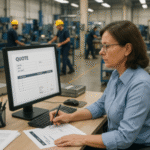
Work Comp Basics for Temporary Staffing
August 13, 2025
Security Guard Workers’ Comp Renewal Checklist: 30-Day Countdown
August 13, 2025in today’s rapidly evolving insurance landscape, the integration of advanced analytics is reshaping how organizations approach risk management and claims processing. Predictive modeling, a data-driven technique that anticipates future outcomes based on historical trends, is emerging as a pivotal tool in workers’ compensation claim prevention. By harnessing the power of predictive analytics, businesses can proactively identify high-risk scenarios, mitigate potential injuries, and reduce claim frequency and costs. This article explores how predictive modeling is transforming workers’ comp strategies, offering insurers and employers a forward-thinking approach to safeguarding workforce health and optimizing operational efficiencies.
Table of Contents
- Understanding Predictive Modeling in Workers Compensation Claims
- Key Data Analytics Techniques Driving Claim Prevention
- Implementing predictive Models for Proactive Risk Management
- Best Practices for Integrating Predictive Insights into Safety Programs
- Q&A
- In Conclusion
Understanding Predictive Modeling in Workers Compensation Claims
Predictive modeling leverages advanced analytics to transform raw data into actionable insights, enabling organizations to anticipate the trajectory of workers compensation claims before they escalate. By analyzing historical claims data alongside real-time factors such as employee demographics, workplace conditions, and injury types, companies can identify patterns indicative of higher risk. This anticipatory approach facilitates proactive intervention, reducing claim frequency and severity, and ultimately driving down operational costs.
Key benefits of predictive modeling include:
- Early identification of high-risk claims for targeted management
- Improved resource allocation by focusing efforts where they have maximum impact
- Reduction in claim processing times through streamlined prioritization
Below is a concise overview of typical predictive factors used in workers compensation analytics:
| Predictive Factor | Description | Impact Level |
|---|---|---|
| Employee age | Correlation with injury susceptibility | Medium |
| Injury Type | Severity prediction for claim cost | High |
| Job Role | Risk profiling based on task hazards | High |
| Previous Claims History | Tendency to recurrent injuries | High |
| Work Surroundings | Exposure to unsafe conditions | Medium |
Key data Analytics Techniques Driving Claim prevention
Data mining and machine learning algorithms stand at the forefront of transforming how organizations address workers’ compensation claims. By analyzing vast datasets, these techniques identify patterns and risk factors before claims occur, enabling proactive steps that reduce incidents. Key methods such as classification models, clustering, and regression analysis help pinpoint vulnerable job roles, predict injury likelihood, and assess the impact of workplace changes. Incorporating these insights into decision-making empowers insurance providers and employers to allocate resources efficiently and tailor safety protocols tailored to specific risk profiles.
- Classification models: Categorize employees based on risk levels.
- Clustering: Detects groups with similar injury tendencies.
- Regression Analysis: Quantifies relationships between workplace factors and claim frequency.
- Natural language Processing (NLP): Extracts valuable information from incident reports.
| Technique | Application | Benefit |
|---|---|---|
| Predictive Analytics | Forecast injury likelihood | Preemptive resource allocation |
| behavioral Analytics | Monitor employee actions | Early intervention alerts |
| Real-Time Monitoring | Continuous data collection | Instant risk identification |
Advanced visualization tools further enhance these techniques by presenting complex datasets in intuitive dashboards, delivering actionable insights at a glance. When combined with IoT devices and wearable tech, data analytics moves beyond historical analysis into real-time claim prevention. This continuous feedback loop allows managers to adapt safety procedures dynamically, fostering a culture of vigilance and reducing claim rates substantially while improving overall workforce health and morale.
Implementing Predictive Models for Proactive Risk Management
Integrating predictive models into workers’ compensation processes empowers organizations to anticipate risks before they escalate into costly claims. By harnessing data from diverse sources-such as historical claim records, employee demographics, and workplace conditions-businesses can create dynamic risk profiles that evolve in real-time.This proactive approach enables early intervention strategies, minimizing injury potential and optimizing resource allocation to areas of highest concern. The result is a transformative shift from reactive claim management to strategic risk mitigation.
- Enhanced Data Analytics: Leveraging AI and machine learning to identify subtle risk indicators.
- Real-Time Monitoring: Continuous surveillance of workplace metrics to flag emerging hazards.
- Customized Safety Programs: Tailored interventions that address specific risk factors.
- Improved Stakeholder Collaboration: Facilitating communication among HR, safety teams, and insurers.
| predictive Model Feature | Impact on Risk Management |
|---|---|
| Early Warning Alerts | Timely identification of potential claim triggers |
| Trend Analysis | Insights into evolving workplace hazards |
| Behavioral Pattern recognition | Detection of unsafe employee practices |
| Resource Optimization | Efficient deployment of safety measures |
Best Practices for Integrating Predictive Insights into Safety Programs
To harness the full potential of predictive insights within your safety protocols, it is indeed critical to establish a robust framework that promotes data-driven decision-making. start by integrating predictive analytics seamlessly with existing safety management systems, ensuring real-time access to risk forecasts and actionable intelligence. Engage cross-functional teams early-combining the expertise of safety officers, data scientists, and frontline supervisors-to align predictive models with practical operational needs. Clear communication of insights empowers all stakeholders to proactively identify hazards and intervene before claims occur.
Equally critically important is prioritizing continuous monitoring and iterative refinement of predictive tools. Establish clear KPIs such as reduction in incident frequency, pace of claim resolution, and accuracy of risk predictions, then systematically track progress through dashboards tailored to both executive and on-the-ground users.Consider adopting a phased implementation approach,starting with pilot projects in high-risk departments before scaling enterprise-wide. The table below highlights key considerations that differentiate accomplished integrations from less effective attempts:
| Best Practice | Impact | Actionable Tip |
|---|---|---|
| Cross-Departmental Collaboration | Enhanced buy-in and insight quality | Form a safety analytics committee |
| Real-Time Dashboarding | Faster risk mitigation | Deploy role-specific reports |
| Iterative Model Updates | Increased prediction accuracy | Schedule quarterly reviews |
| Pilot Testing | Lower implementation risk | Start with critical areas |
Q&A
Q&A: Predictive Modeling - The Future of Workers’ compensation claim Prevention
Q1: What is predictive modeling in the context of workers’ compensation?
A1: predictive modeling refers to the use of advanced data analytics and machine learning algorithms to analyze historical workers’ compensation data. By identifying patterns and risk factors, it enables businesses and insurers to anticipate potential workplace injuries and claims before they occur.
Q2: How does predictive modeling improve workers’ compensation claim prevention?
A2: Predictive modeling helps identify high-risk employees, job roles, or work environments by analyzing various data points such as past incidents, safety reports, and employee demographics. This insight allows organizations to implement targeted interventions, enhance training programs, and adjust safety protocols proactively, thereby reducing the likelihood of claims.Q3: What types of data are used in predictive models for workers’ comp?
A3: Models typically incorporate claims history, incident reports, health and safety audits, employee work schedules, ergonomic assessments, and even external factors such as weather conditions or economic trends. Integrating diverse data sources increases the accuracy and relevance of predictions.
Q4: What are the benefits of implementing predictive modeling in workers’ compensation management?
A4: Key benefits include reduced claim frequency and severity, lower insurance premiums, improved workplace safety culture, and enhanced operational efficiency. Moreover, early identification of risks fosters employee well-being and can lead to greater overall productivity.
Q5: Are there challenges businesses face when adopting predictive modeling for claim prevention?
A5: Yes.Challenges include data quality and availability, integrating predictive tools into existing workflows, ensuring privacy and compliance with regulations, and securing buy-in from leadership and employees. Addressing these challenges requires a strategic approach and collaboration between data scientists, HR, and safety teams.
Q6: How can companies get started with predictive modeling for workers’ comp claims?
A6: Companies should begin by assessing their current data infrastructure and identifying key metrics related to workplace injuries. partnering with experienced analytics providers or insurers that offer predictive modeling capabilities can accelerate implementation. additionally,fostering a data-driven culture and training staff on interpreting predictive insights are essential steps.
Q7: What trends are shaping the future of predictive modeling in workers’ compensation?
A7: The integration of real-time data from wearable devices, advances in artificial intelligence, and more complex risk scoring methods are driving innovation. Additionally, there is growing emphasis on personalized risk management and continuous monitoring to adapt safety measures dynamically.
This Q&A offers executives and managers a foundational understanding of how predictive modeling is transforming workers’ compensation claim prevention and why embracing these tools is becoming a competitive necessity.
In Conclusion
predictive modeling stands at the forefront of transforming workers’ compensation claim prevention. By harnessing advanced data analytics and machine learning, organizations can proactively identify risks, streamline interventions, and ultimately reduce both claim frequency and associated costs. As the technology continues to evolve, businesses that integrate predictive modeling into their risk management strategies will not only enhance employee safety but also gain a important competitive advantage in an increasingly data-driven landscape.Embracing this innovative approach is no longer optional-it is imperative for the future of effective workers’ compensation management.
“This content was generated with the assistance of artificial intelligence. While we strive for accuracy, AI-generated content may not always reflect the most current information or professional advice. Users are encouraged to independently verify critical information and, where appropriate, consult with qualified professionals, lawyers, state statutes and regulations & NCCI rules & manuals before making decisions based on this content.







